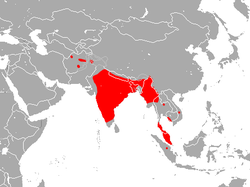| Blyth's horseshoe bat | |
|---|---|
 | |
| Scientific classification | |
| Kingdom: | Animalia |
| Phylum: | Chordata |
| Class: | Mammalia |
| Order: | Chiroptera |
| Family: | Rhinolophidae |
| Genus: | Rhinolophus |
| Species: | R. lepidus |
| Binomial name | |
| Rhinolophus lepidus Blyth, 1844 | |
 | |
| Blyth's Horseshoe Bat range | |
Blyth's horseshoe bat (Rhinolophus lepidus) is a species of bat in the family Rhinolophidae. It is found across southern Asia from Afghanistan to Vietnam. The species can be identified from its pointed, bifid sella.
